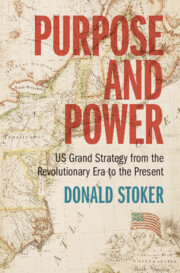Book contents
- Purpose and Power
- Purpose and Power
- Copyright page
- Dedication
- Contents
- Figures
- Maps
- Abbreviations
- Thinking about Grand Strategy in Peace and War
- Part I From Backwater to Great Power
- Part II From Great Power to Superpower
- Part III The Post–Cold War World
- 16 The Gulf War, or First Iraq War, 1990–1991
- 17 The New World Disorder: Bush and Clinton, 1991–2001
- 18 Wilsonian Revolutionaries: The Bush Administration, 2001–2009
- Part IV Retreat and Defeat
- Acknowledgements
- Notes
- Index
17 - The New World Disorder: Bush and Clinton, 1991–2001
from Part III - The Post–Cold War World
Published online by Cambridge University Press: 11 January 2024
- Purpose and Power
- Purpose and Power
- Copyright page
- Dedication
- Contents
- Figures
- Maps
- Abbreviations
- Thinking about Grand Strategy in Peace and War
- Part I From Backwater to Great Power
- Part II From Great Power to Superpower
- Part III The Post–Cold War World
- 16 The Gulf War, or First Iraq War, 1990–1991
- 17 The New World Disorder: Bush and Clinton, 1991–2001
- 18 Wilsonian Revolutionaries: The Bush Administration, 2001–2009
- Part IV Retreat and Defeat
- Acknowledgements
- Notes
- Index
Summary
The George H. W. Bush administration proceeded to consolidate the US victory in the Cold War. It wanted a New World Order, a democratic peace to replace the Cold War competition. It began NATO expansion to Eastern Europe and became involved in Somalia but remained aloof from the growing tragedies in former Yugoslavia. Bill Clinton succeeded Bush as president. He combined no interest in foreign affairs with no knowledge of them, and insisted there was no such thing as grand strategy. He emphasized economics above all else and followed one course while his national security team followed another. The administration bungled regime efforts in Somalia and Haiti. National Security advisor Anthony Lake tried to implement a grand strategy of democratic enlargement, but other administration figures gave little support. The administration continued NATO expansion, fought wars in Bosnia and Kosovo against the Serbs, and waged a low-level struggle against Iraq. Clinton produced a budget surplus and economic growth.
Keywords
- Type
- Chapter
- Information
- Purpose and PowerUS Grand Strategy from the Revolutionary Era to the Present, pp. 560 - 588Publisher: Cambridge University PressPrint publication year: 2024



